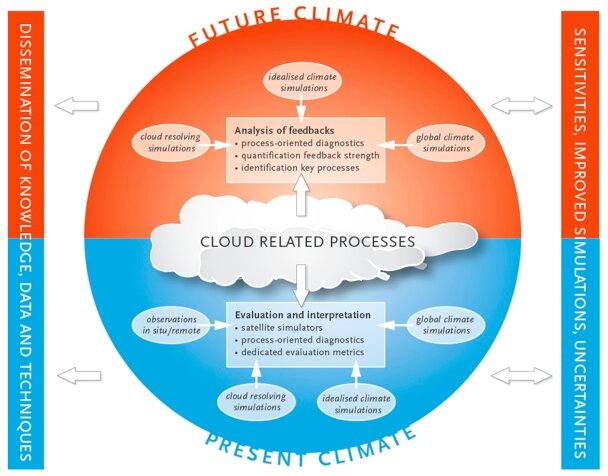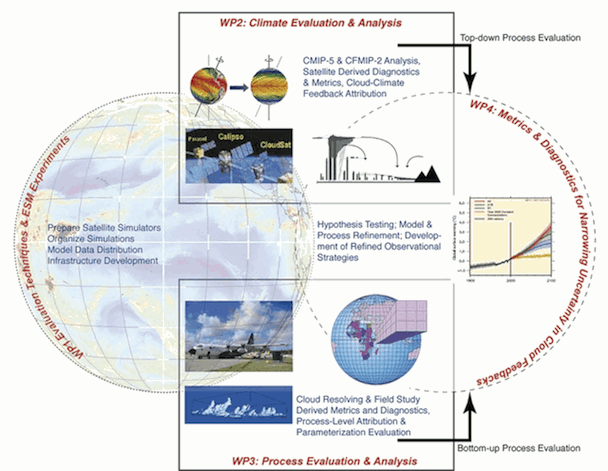Overview and goals
The EUCLIPSE project is an international effort, funded under theme 9 "Environment" of Framework Program 7 of the European Union, designed to improve the evaluation, understanding and description of the role of clouds in the Earth's climate with a focus on the cloud feedback in a warming climate. The concept of EUCLIPSE is summarized in the figure below.

Cloud feedbacks in Earth System Models (ESMs) remain the largest source of uncertainty in projections of future climate. They are also a major contributor to uncertainty in other feedbacks (e.g., surface albedo, carbon cycle) in the Earth System. Through interactions with the large-scale circulation, cloud processes also contribute to synoptic circulations and regional climate. They are therefore critical to the prediction of future changes in precipitation patterns, climate variability and extreme events.
The central objective of EUCLIPSE is to reduce the uncertainty in the representation of cloud processes and feedbacks in the new generation of Earth System Models (ESMs), in support of the IPCC's fifth assessment report. Novel, process-oriented evaluations of clouds in present-day and future climate simulations made by the leading European ESMs will identify the cloud types and processes responsible for the spread in climate sensitivity and future precipitation changes across the models, and for deficiencies in the simulation of the present-day climate. The new diagnostics and metrics developed in EUCLIPSE will inform targeted sensitivity experiments to isolate the processes responsible for cloud feedback uncertainty.
In EUCLIPSE, four distinct communities will work together across a set of integrated work packages over a four-year period: the observational community will provide state-of-the-art measurements from ground- and space-based active and passive remote sensing; the numerical weather prediction community will provide analyses of short timescale model biases induced by cloud processes; the cloud modeling community will provide fine-scale models as an additional tool for understanding cloud behavior in a changing climate; finally, the climate modeling community will synthesize the physical understanding and observational constraints identified by the other communities to improve the representation and assessment of cloud processes in ESMs and so improve the predictive skill of ESMs.
The strength of the EUCLIPSE project is the combination of detailed modeling and observation at the level of individual clouds and the evaluation and analysis of clouds in the climate system in global climate models using the latest diagnostic techniques and satellite products. The work is divided among four work packages as illustrated in the figure below.

The EUCLIPSE project is a collaborative effort of these 12 institutes:
- Royal Netherlands Meteorological Institute, Netherlands
- Max Planck Institute for Meteorology, Germany
- Met Office, United Kingdom
- Centre National de la Recherche Scientifique Institute Pierre Simon Laplace, France
- Academy of Athens, Greece
- European Centre of Medium Range Weather Forecasts, United Kingdom
- Delft University of Technology, the Netherlands
- Météo-France, France
- University of Stockholm, Sweden
- Eidgenössische Technische Hochschule Zürich, Switzerland
- University of Warsaw, Poland
- German High Performance Computing Centre for Climate- and Earth System Research, Germany
